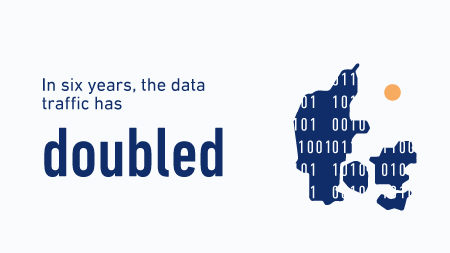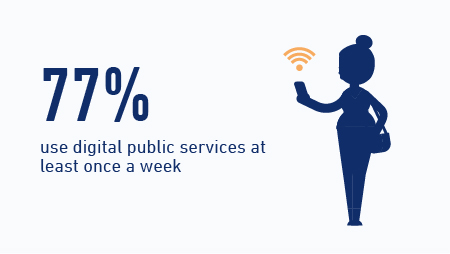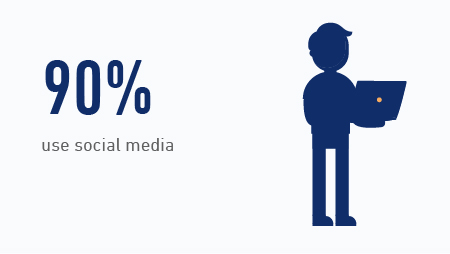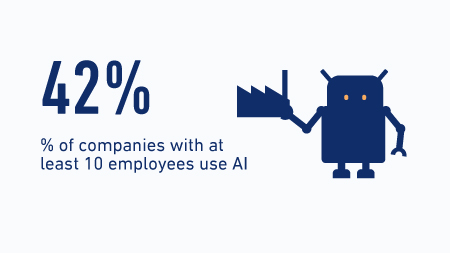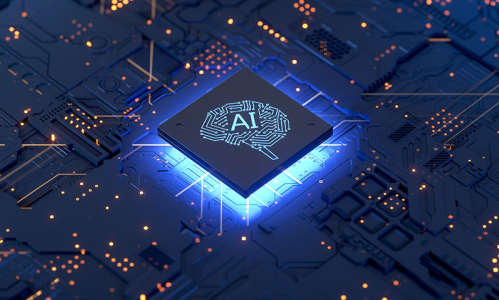Digitalisation
From telephone points to 5G coverage. From stationery to electronic mail. From manual labour to robotics. Today, Denmark is one of Europe’s most digitised countries. With advanced tools, we continue to increase our efficiency and optimise, create welfare and growth. At the same time, we have become vulnerable to new threats such as hacker attacks and identity theft. This theme focuses on digital Denmark.
State of digital development and infrastructure
How digital are we in Denmark? It can be difficult to give a clear answer, but a wide range of statistics suggest that we are among the most digitised countries in Europe. For example, we are at an advanced stage when looking at our internet access and the use of digital services. Similarly, we are ahead in terms of the digital skills of the population and the use of advanced technology in companies. In this theme, we will look into all of this and more.
Key indicators of digitalisation in Denmark
Digitalisation in the EU
Over a number of years, the EU Commission compared the state of digital development across European countries in the publication Digital Economy and Society Index (DESI). The comparison covered four primary parameters: Human capital, Connectivity, Integration of digital technology and Digital public services. In 2022, Denmark took second place in the combined DESI assessment, exceeded only by Finland. The placement is primarily due to Denmark's high score on Connectivity and Digital public services (read more about this in the next section).
Digital Economy and Society Index (DESI) 2022
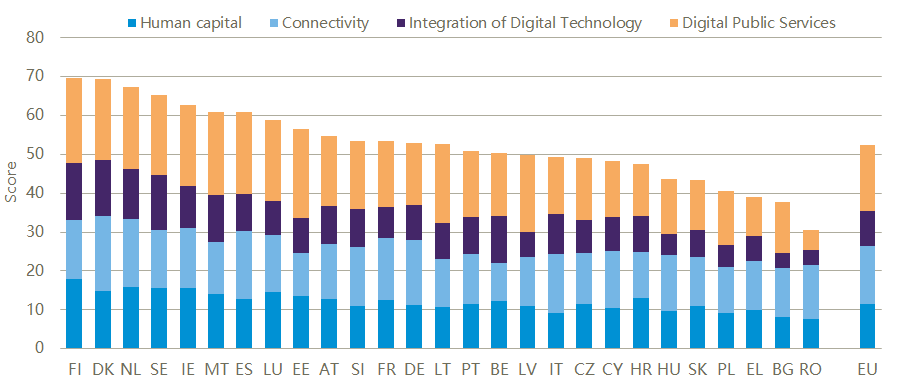
Source: Eurostat
What is the Digital Economy and Society Index/Digital Decade report?
EU focuses on supporting the digital transformation in Europe. From 2014 to 2022, the EU Commission published the ’Digital Economy and Society Index (DESI)’. In addition to measuring the digital progress of the European countries, the index helped identify areas that required action. In 2023, the project was renamed the Digital Decade report, which now focuses on significantly fewer indicators.
Visit the Digital Economy and Society Index or the Digital Decade report
Comparisons across continents
In the OECD’s ’Going Digital Toolkit’, you can compare the state of digital development in countries from all over the world, although primarily member states. This applies to countries such as Australia, Denmark, Ireland, Israel, Japan and the USA. Their state is measured using seven different parameters.
Connectivity
According to the 'Digital Economy and Society Index (DESI)’, Denmark had the best connectivity in the EU in 2022. This is especially due to our widespread use of networks and wide network coverage. Compared to the rest of the EU, Denmark has been quick to ensure the digital infrastructure with the roll-out of new network technologies (for example 5G broadband and fibre network) throughout the country and not just in city areas.
Connectivity, DESI 2022
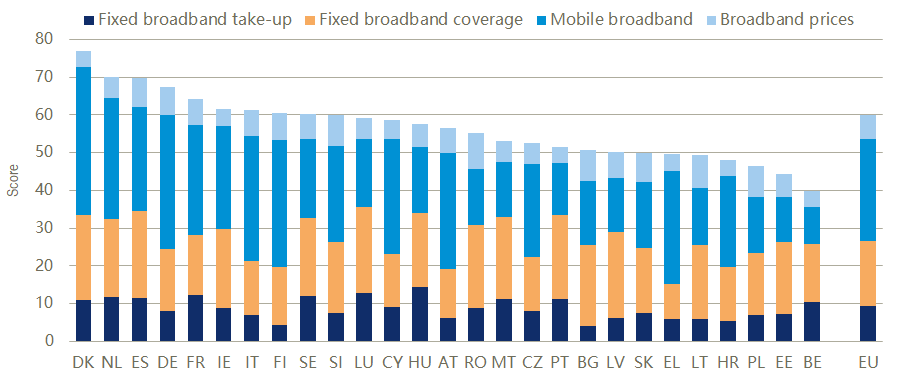
Source: Eurostat
Data traffic
As the broadband capacity in Denmark has expanded, internet usage has become increasingly intensive among the population. Most households have access to the internet around the clock, and we are streaming and downloading data like never before, e.g. with tv series, video clips, music, podcasts, etc. Thus, we are experiencing a steep rise in data traffic, which has more than doubled in six years - from 3.3 m terabytes in the second half of 2018 to 8,9 m terabytes in the second half of 2024.
Total data traffic in Denmark, half-yearly
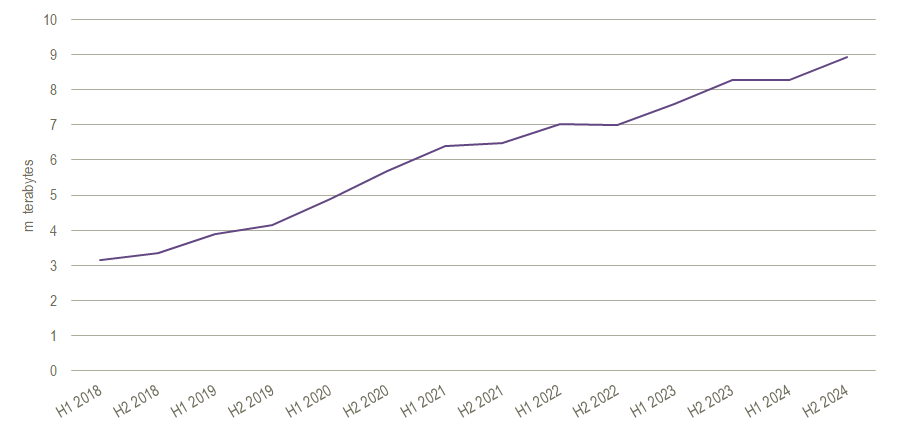
Source: Agency for Digital Government (in Danish). The figures include fixed-line as well as mobile data traffic.
Digitalisation of public services
Like digital infrastructure, the use of public digital services also gives a good indication of a country’s state of digital development. Do all citizens, for example, have the possibility to access digital services? Do they use the services frequently, so that the services are an integral part of the digital culture? For the digitalisation of public services to work optimally, it is important to include of as many citizens as possible.
Use of public digital services
In general, the population frequently uses public digital services. Part of the success is due to Denmark’s introduction of mandatory digital self-service in 2015. This has meant that solutions such as Digital Post and e-Boks have largely replaced physical mail from public authorities. In the same way, the digital citizen services (Borger.dk, etc.) have gained ground, while there are fewer physical citizen services centres. The Danish Agency for Digital Government is responsible for many of the public digital services, including the app for the national health insurance card, which was launched in 2021.
Use of selected digital public services, 2024
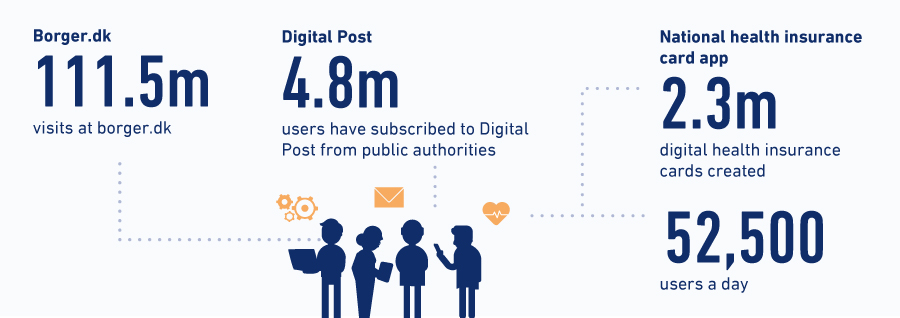 Source: The Danish Agency for Digital Government (in Danish)
Source: The Danish Agency for Digital Government (in Danish)
Frequency of use
Of the population between 15 and 89 years, 77 per cent used public digital services at least once a week in 2024. In this age group, 7 per cent never used them.
Of the 25-34-year-olds, 87 per cent used the services at least once a week. The 85-89-year-olds are the least active with 40 per cent using the services at least once a week.
How often do you use digital public services?
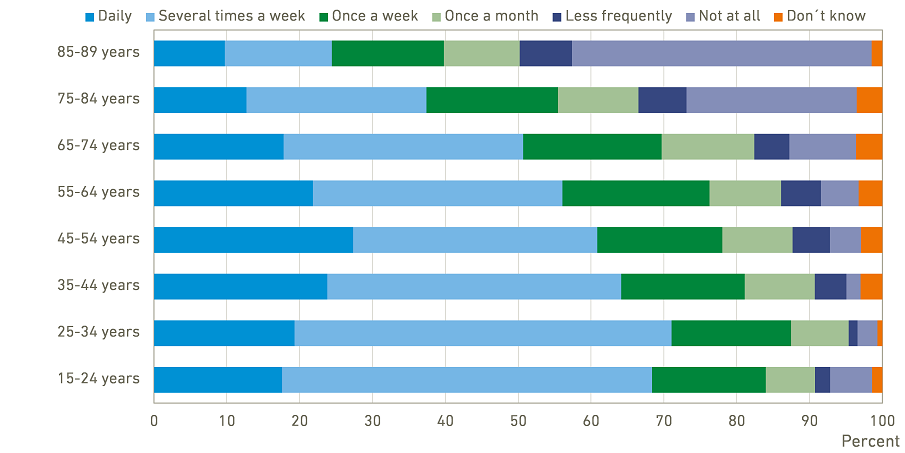
Source: ICT usage in households and by individuals 2024 (in Danish)
Confidence in public digital services
The comprehensive digitalisation of the public sector – in line with the digitalisation in general – has introduced a sweeping vulnerability to digital threats. The public sector works on reducing the risk of data leaks, hacking and abuse of data by implementing different security technologies and procedures, for example the launch of NemID and MitID in 2010 and 2022 respectively.
In general, the population has much confidence in the state being able to handle the task. In the survey ‘ICT usage in households and by individuals’, 81 per cent agree or strongly agree with the statement "I generally trust public digital solutions", whereas 5 per cent of the population disagrees or strongly disagrees.
I generally trust public digital solutions, 2024
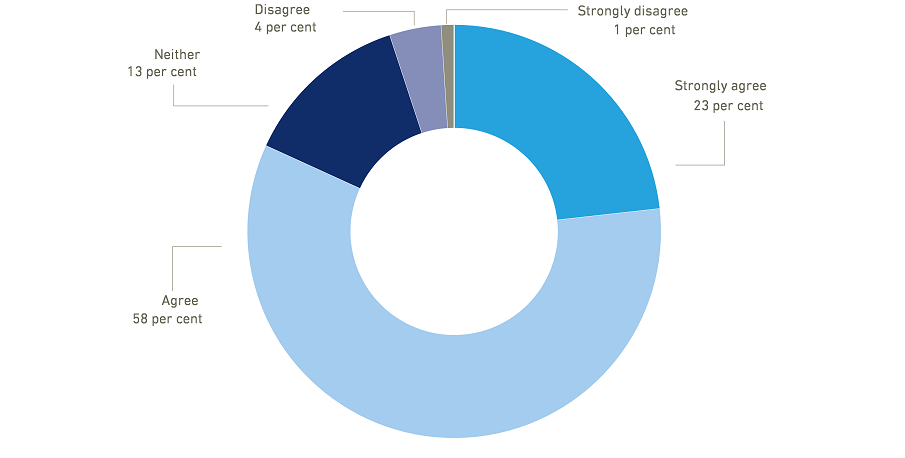
Source: ICT usage in households and by individuals 2024 (in Danish)
ICT usage in households and by individuals
’ICT usage in households and by individuals’ is an annual survey of the general public access to and use of internet, new technologies and digital solutions. The survey is carried out via questionnaires and deals with topics such as e-commerce, digital public self-service, entertainment, social media, smart-home solutions, IT security and so on. Some of the questions are not included every year, but every other year or less frequently. The survey has been published as an annual publication since 2009.
Digital skills
The digital development has also led to the population acquiring a completely new set of skills. Not just for work purposes, but also for recreational purposes and home use where new technology and digital tools continue to make demands on our abilities and competences. The focus on digital skills in public school has intensified, and an increasing number of students choose an education in the field of technology.
Basic digital skills
Each year, the European Commission compares the digital skills among citizens in the European countries. The skills measured are skills such as sending and receiving emails, finding information online, using software to write texts and process data, using online banking and protecting personal online data. In 2023, Denmark took an overall third place in terms of citizens with either “basic" or “above basic" digital skills. The two groups accounted for 30 and 39 per cent respectively of the population in Denmark. The EU average was 28 per cent and 27 per cent respectively.
Digital skills in selected European countries, 2023
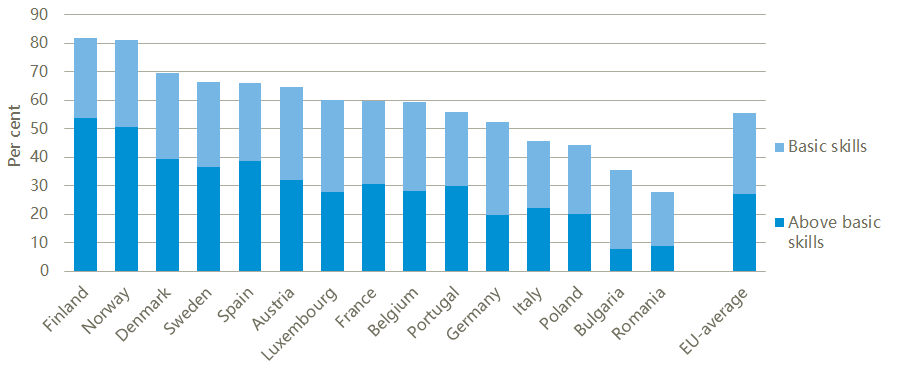
Source: Eurostat
The last time Eurostat measured digital skills (2021), Iceland took an overall first place. Unfortunately, there are no figures from Iceland in 2023.
Digitally limited citizens
Even though a large part of the Danish population has good digital skills, a group of people still struggle to keep up. Almost 1,140,000 citizens, corresponding to 23 per cent of the age group 15-89 years, feel “digitally limited”. This group is defined based either on the fact that they have been online either never or more than a year ago, or they feel limited in at least one of seven selected online activities (including information search, online shopping, etc.) Elderly people heavily dominate the group of digitally limited.
Share of digitally limited among different age groups, 2023
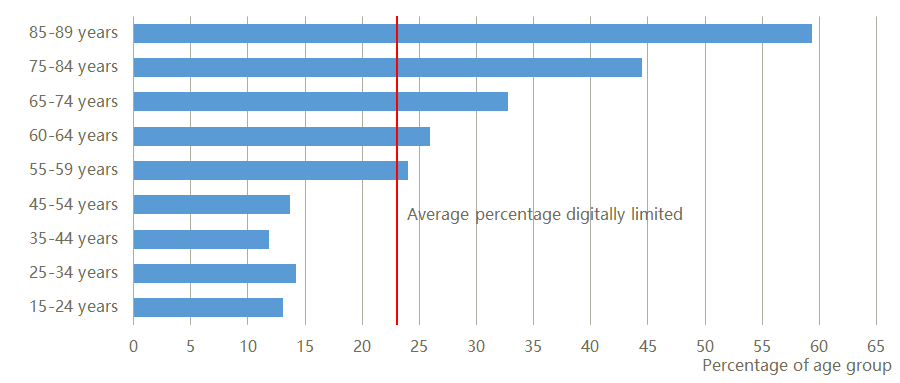
Source: ICT usage in households and by individuals 2023 (in Danish; see the publication for a definition of digitally limited).
Non-users
Looking back on the past 17 years, there have been less and less non-users of the internet. In 2008, 12 per cent of the population were non-users against 0 per cent i 2025. The group of elderly citizens have come especially far.
Students in STEM education
Parallel with technological developments, the number of students in the so-called STEM education programmes has increased. STEM stands for Science, Technology, Engineering, and Mathematics – academic disciplines of great importance in driving the technological and digital development. For example, mathematical algorithms are pivotal in the development of social media, search engines, AI, etc. Approximately 68,000 students were enrolled in further STEM education in 2024, corresponding to 27 per cent of students enrolled in further education. Of all students enrolled in further education, 41 per cent of the male students and 17 per cent of the female students were enrolled in a STEM programme in 2024.
Digitalisation in private life
Digitalisation has left its mark on every corner of society, including our homes. New digital tools have given us smart homes, made household chores less time-consuming and made entertainment from across the world more readily available. We are all online, but what are we doing with our online time?
Internet usage – communication and democracy
The majority of the population (16-74-year-olds) use the internet to communicate with other people. For example writing emails to each other, sending messages through various apps, such as Messenger and Snapchat, and making video and phone calls online. A minor part of the population also uses the internet to take part in democratic actions, for example by making personal statements on blogs and social media and participating in online hearings, polls or signing petitions.

Internet usage – news
The penetration of digital media in society has changed the way the population gets news and finds information. Today, the largest share of the population gets their news from online newspapers and news apps, and social media also represents a significant source of current information. In 2018 (Q3), 30% of the population consumed news from social media - 31% from printed media (statbank.dk/KV2NYH1).
Internet usage – entertainment
As with the consumption of news, there has been a major change in the way we consume entertainment. Where many entertainment products previously required their own playing devices (CDs, DVDs, radio, etc.), you can access more or less all types of entertainment today from the same device via streaming. In this way, the majority of the population (16-74 years) is streaming music, films and series from various online services.
Examples of video content sharing services are YouTube and Vimeo, of streaming from TV stations: Dr.dk and TV2Play, and of streaming from commercial providers: Netflix and Disney Plus.
Internet usage for selected entertainment, 2024
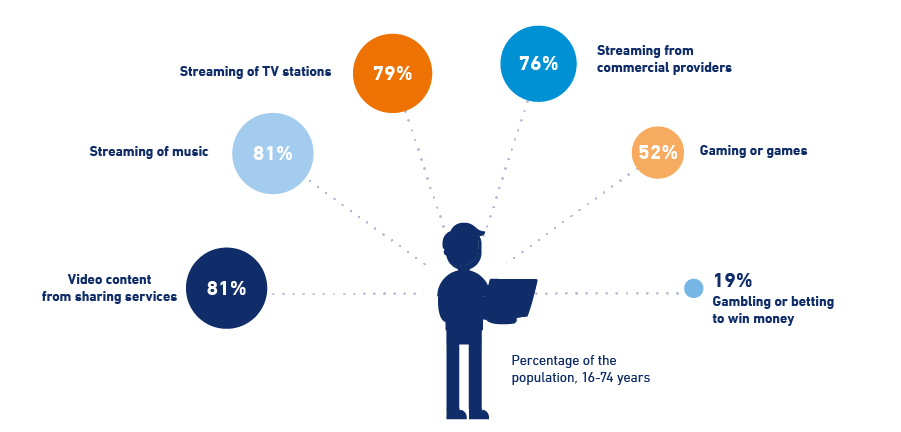
Source: www.statbank.dk/BEBRIT09
New and old technology
The rapid advance of digitalisation has led to new technology replacing old technology with an increasing speed. Digital products are becoming obsolete in the course of just a few years. Unsurprisingly, as new technology has made laptops (portable computers) lighter and more popular, stationary ownership has declined. The trend is the same for smartphones and fixed line telephones.
Use of generative AI
In 2022, generative AI was launched as a digital tool in Denmark and has since become very popular. In 2025, 48 percent of the population have used generative AI tools, and there is a clear difference in the usage across age groups. The younger people are, the higher the usage.
Smart homes
Still more citizens are investing in so-called smart-home solutions for their homes. In 2024, this was the case for 48 per cent of the 16-74-year-olds - an increase from 42 per cent in 2022. Smart-home solutions use sensors, microphones and digital measurements to control resource consumption in your home and let robots do household chores. The solutions include voice-controlled smart assistants, robotic vacuum cleaners and solutions for controlling electricity, heating and the like.
Smart solutions in the home, per cent of 16-74-year-old population, 2024

Consumption of electronic products and services
Never before has the population spent so much money on electronic products and services. In 2023, the average household spent more than twice as much on computers and tablets as in 2015. On the other hand, the category "Subscription to audio-visual content, streaming services and rentals of audio-visual content etc." dropped significantly between 2015 and 2020, which can be attributed to the many changes that occurred in the market in that period.
The figures are stated in constant prices, i.e. adjusted for inflation.
Digitalisation in the corporate sector
Digital developments have had a major impact on the corporate sector. Many enterprises have undergone major changes with the implementation of new and more advanced technologies such as Big Data analysis, robotics and artificial intelligence. This development has led to innovation and presumably increased competitiveness, but it has also presented certain challenges, for example in terms of recruitment.
ICT specialists
From letter to email, from customer service to chatbots. As more tools and processes have become digital in the workplace, we see more and more companies hiring employees to handle ICT-related tasks. In 2024, a third of all companies with at least 10 employees employed ICT specialists.
Difficult to recruit
Danish companies are increasingly experiencing a shortage of employees with the right skills for ICT development and operations. In 2024, 8 per cent of all companies had ICT vacancies that they could not fill. The challenges of finding ICT specialists are particularly prevalent in the 'Information and Communication' industry, where 33 per cent of companies have experienced the problem. The larger the organisation, the more prevalent the challenge.

Working remotely
The many digital opportunities in companies have led to an increasing proportion of employees working remotely - for short or long periods of time. The development of advanced communication technology such as email, chat, video conferencing and more has reduced the need for physical presence in the workplace, and the COVID-19 pandemic has been a major catalyst for this development. From 2018 to 2024, the number of employees working from home has increased by 60 per cent.
Artificial Intelligence
In recent years, there has been a significant increase in the share of companies using artificial intelligence.
Note: Figures for 2025 include the subcategory “Artificial intelligence for generating images, video, and audio.” This sub-question was not asked in previous years.
The larger the company, the higher the usage of artificial intelligence. In 2025, 75 percent of companies with more than 250 employees used at least one type of AI-based technology. The share was 37 percent among companies with 10–49 employees.
Artificial intelligence is most widespread in the Information and Communication industry, where 79 percent of companies use it (www.statbank.dk/ITAV19).
See also:
Large language models and the Danish labour market
8 February 2024
Which industries can benefit the most from generative artificial intelligence (AI)? Which work functions might change the most as a result of its use? The analysis examines the impact of language models on the Danish labour market.
ICT usage in enterprises
Some of the information in this section comes from the annual survey ‘ICT usage in enterprises', which is designed to shed light on enterprise usage of information technology (including advanced technology, e-commerce, etc.), benefits and barriers when using different technologies, use of ICT specialists, etc. The survey is made via a questionnaire and first came out in 1998. Some questions are not included every year, but every other year or less frequently.
Find more figures from ‘ICT usage in enterprises’ in Statbank Denmark
Digital economy
The technological development has brought about a proper digital economy. It is centred around companies working - either primarily or partially - to develop, produce and market digital goods and services. At the same time, an increasing share of the population has become interested in e-commerce, where physical goods and services are sold alongside digital alternatives.
Digital goods and services
In the wake of digitalisation, a group of goods and services has come about that can only be accessed digitally. This includes music, films and series that used to take up metres of shelf space but can now be streamed and downloaded online. Tickets for cinemas, concerts etc. are stored in the digital cloud and can be viewed on a smartphone.
Have purchased within the last three months, per cent of 16-74-year-olds, 2024
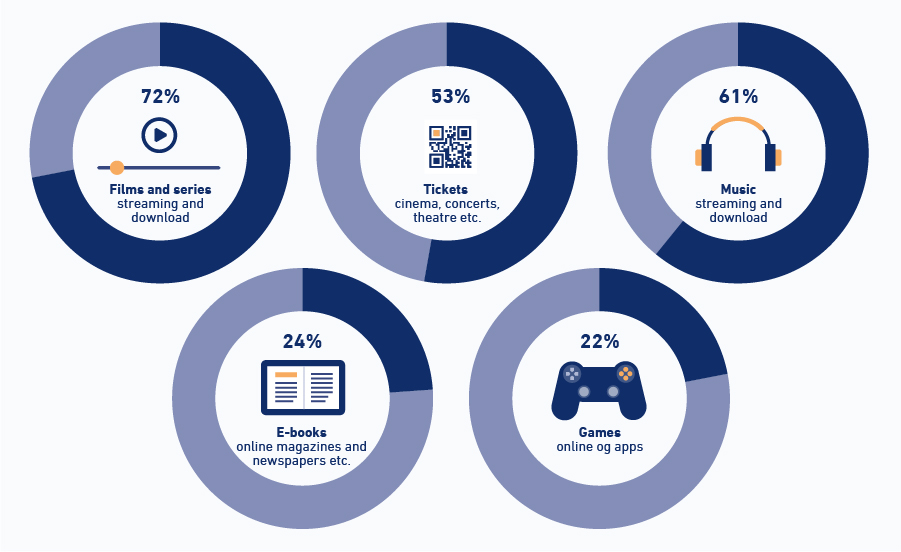
Source: ICT usage in households and by individuals 2024 (in Danish)
E-commerce
E-commerce has been growing steadily over the past 17 years. In 2008, only 47 per cent of the population had shopped online within the last three months against 82 per cent in 2025. In this context, it is interesting that, until 2016, men outnumbered women in the group of online shoppers. The trend then switched, and women outnumbered men. In 2022, e-commerce declined after large increases in both 2020 and 2021, which could be due to more people returning to physical shops after the COVID-19 pandemic. In 2024, however, e-commerce was back to the 2021 level.
E-commerce versus physical commerce
The increasing activity in e-commerce does not only show in the population, but also in the flow of money. The value of transactions with Danish payment cards (Dankort, Visa, Mastercard, etc.) in e-commerce has soared since 2016 (Q1). In physical shops, however, the value of transactions is still at a significantly higher level (in fact, it is higher than shown in the figure, since the shops also accept payments in cash).
Digital industries
With technological developments, many digital industries have emerged in Denmark. After the financial crisis in the late 2000s, the industries have grown steadily and today contribute significantly to the Danish economy. The industries include companies involved in developing, producing or selling digital goods and services, either wholly or partially, and include everything from electronics manufacturers and game developers to computer retailers and IT consultancies.
Key figures for the digital industries, 2023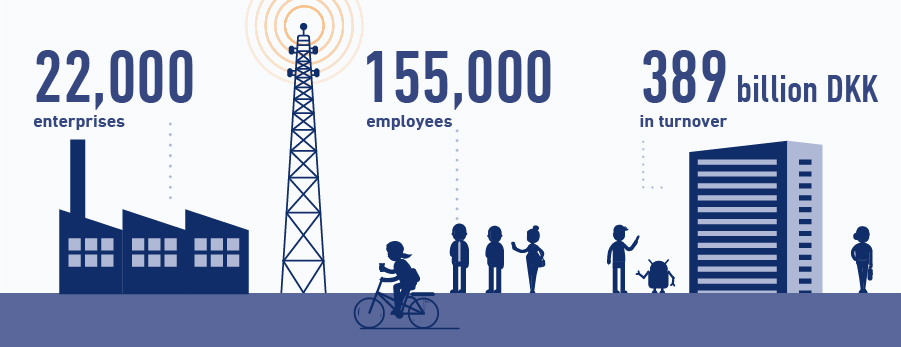
Source: www.statbank.dk/GF11, special run. Statistics Denmark has categorised 34 industries as ‘digital industries’ (list in Danish).
In comparison, the non-agricultural private sector in 2023 accounted for: 397,000 enterprises, 3.0 million employees and 5,293 billion DKK in turnover (www.statbank.dk/REGN20).
Misinformation and security
The internet has made many daily activities easier for the population, but it has also created a number challenges. Digital threats such as hacking, identity theft, credit card fraud and financial fraud have become commonplace for citizens as well as enterprises. At the same time, the flow of fast-paced news on social media has made it harder to spot misinformation and disinformation.
Experiences of fake news among the population
As mentioned earlier, websites and social media have increasingly become sources of news for the population. Sometimes, however, the news you find here can be false and misleading. In 2023, two thirds of the respondents in the ‘ICT usage in households and by individuals’ survey said they had seen fake content on the internet in the past three months. This indicates high awareness of misinformation, and especially the younger section of the population aged 16-44 consider themselves good at spotting fake news stories. In general, the trend is that the older you are, the less you pay attention to fake content.
Have seen fake content on the internet, 2023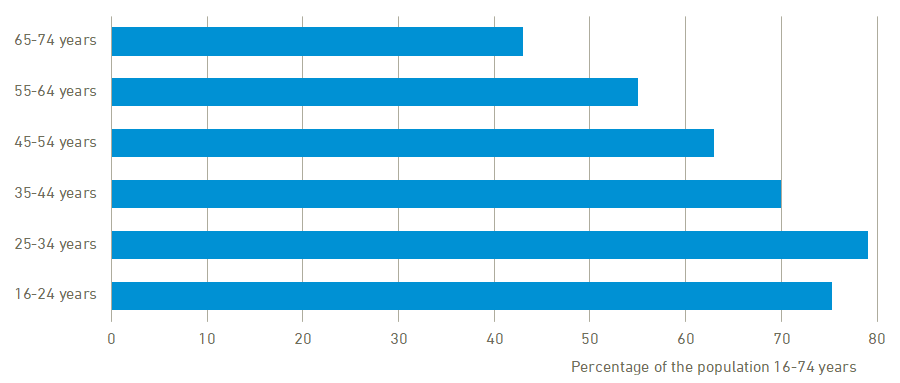
Source: ICT usage in households and by individuals 2023 (in Danish)
Financial fraud
In 2023, fraud on the internet caused 12 per cent of the population to suffer a financial loss. Especially the age groups 25-34 and 35-44 had been the victims of fraud, even though these age groups consider themselves good at spotting fraud (see the figure above). The older age groups were less affected by online fraud. Part of the explanation is probably that the 25-44-year-olds are the most frequent online shoppers and are thus more exposed to interacting with pages involving a risk of fraud.
Have suffered a financial loss due to fraud on the internet, 2023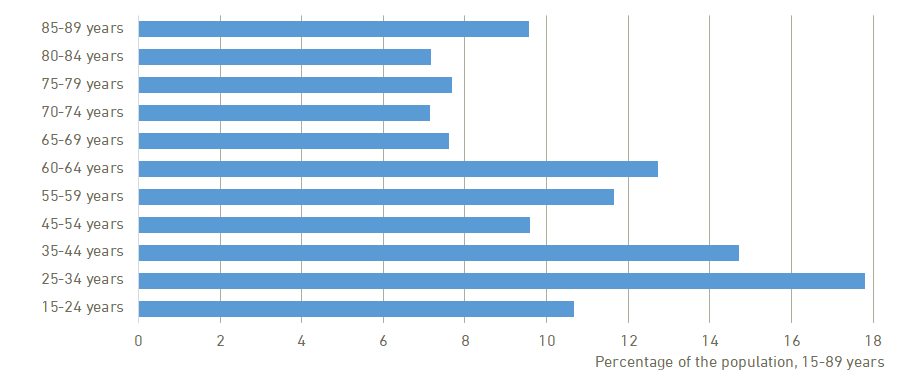
Source: ICT usage in households and by individuals 2023 (in Danish)
Fraud in e-commerce
Part of the financial fraud taking place on the internet is in e-commerce, where a significant amount of Danish payment card fraud takes place every year. However, the value of fraud decreased significantly between 2016 and 2021, probably due to a number of tightened security measures both in Denmark and abroad (e.g. two-step and NemID/MitID authentication in online payments). Danish payment cards are misused especially in connection with online shopping where the payment goes abroad. In 2024 (Q1-Q4), this type of payments accounted for 87 per cent of the total value of fraud. Payments within the Danish borders accounted for 13 per cent.
Note: Fraud with cards in e-commerce includes postal sales and telesales.
IT security measures of the population
It pays to be aware of potential online abuse and fraud, and individuals can take concrete measures to increase online security. In 2024, the most common measures among the population were: 1. To retrieve programs only from reliable websites, and 2. To be careful of giving personal information on social media. About 9 out of 10 citizens take these measures. One of the less used measures was to use passwords of at least 12 characters (41 per cent of the population).
Selected security measures in the population, 2024
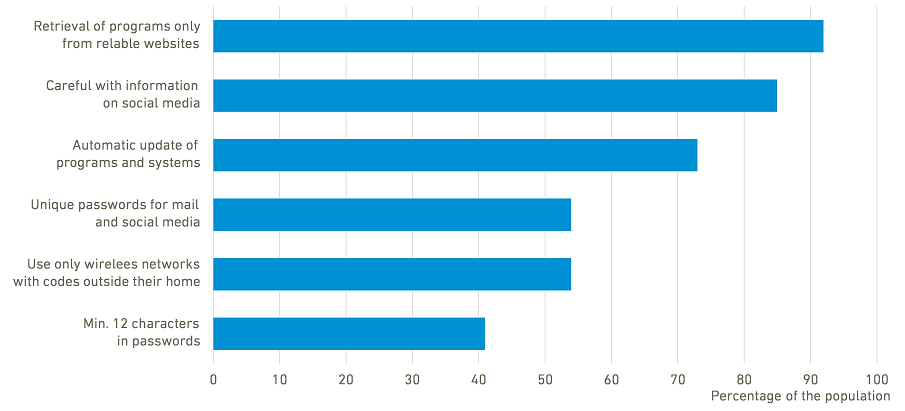
Source: ICT usage in households and by individuals 2024 (in Danish)
IT security measures of enterprises
To protect themselves better against security breaches, Danish companies invest significant sums in IT security every year. More security measures and procedures are continuously being implemented. In 2024, the most common measures in enterprises were: Back-up of data on alternative geographic locations, systematic software updates and access control to the enterprises networks.

Contact persons for this theme page
Anne Vibeke Jacobsen Anne Sofie Hummelmose
T: +45 20 14 84 28 T: + 45 21 15 35 55
E: avj@dst.dk E: asf@dst.dk


